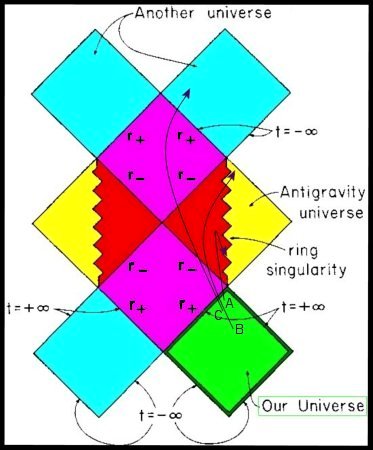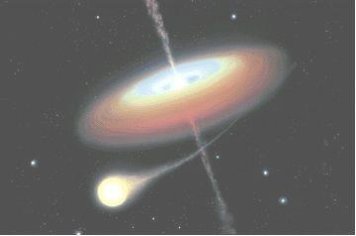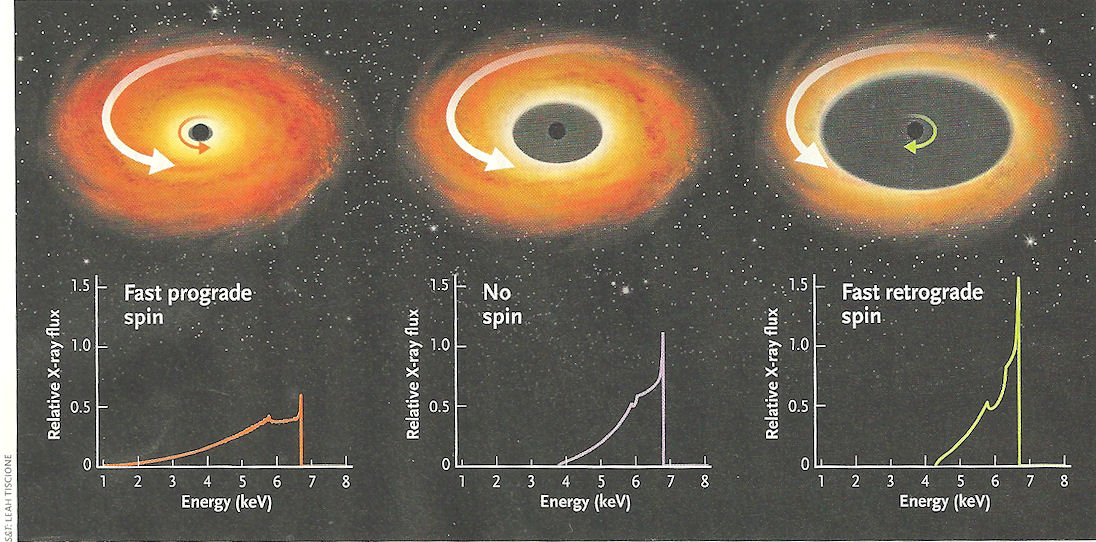
| Home Page | Overview | Site Map | Index | Appendix | Illustration | About | Contact | Update | FAQ |
 was found by Roy Kerr in 1963:
was found by Roy Kerr in 1963: | ---------- (15c) |
 , the Kerr's metric reduces to the one for flat space-time (same as Eq.(14)):
, the Kerr's metric reduces to the one for flat space-time (same as Eq.(14)): d
d 2 + d
2 + d 2) ---------- (15g)
2) ---------- (15g) |
 = 4GM/Rc2, where M is the mass of the source and R is the distance from the source. At the surface of the Sun, = 4GM/Rc2, where M is the mass of the source and R is the distance from the source. At the surface of the Sun,  = 1.75" (derivation from Newtonian mechanics is half as much). This prediction was confirmed by Sir Arthur Eddington's 1919 solar eclipse expeditions. If the light ray comes close enough to a dense = 1.75" (derivation from Newtonian mechanics is half as much). This prediction was confirmed by Sir Arthur Eddington's 1919 solar eclipse expeditions. If the light ray comes close enough to a dense
|
Figure 09m Bending of Light [view large image] |
object, the path will be bent so much that it runs around in a circle. For non-rotating black hole such special trajectory occurs at r = 3rs/2 = 3GM/c2. The sphere with such a radius is called the photon sphere. However, the orbit is unstable; it can be |
 2 = 0. There are two photon spheres for the rotating black hole - an outer one for light ray traveling in a direction opposite to the spin of the black, and an inner one for co-rotating light ray.
2 = 0. There are two photon spheres for the rotating black hole - an outer one for light ray traveling in a direction opposite to the spin of the black, and an inner one for co-rotating light ray.  )1/2] / c2 ---------- (15i)
)1/2] / c2 ---------- (15i) |
This is called static limit. It can be intuitively characterized as the region where the rotation of the space-time is dragged along with the velocity of light. Within this region, space-time is warped in such a way that no observer can maintain him/herself in a non-rotating orbit, but is forced to become co-rotating (Figure 09n). The surface of this region is elliptical with its major axis at  = =  /2 (the equator), and r = 2GM / c2 (= the non- /2 (the equator), and r = 2GM / c2 (= the non-
|
Figure 09n Frame Dragging |
rotating Schwarzschild's radius). The minor axis is in the directions of  = 0, and = 0, and  (the poles), and r = [GM + (G2M2 - a2c2)1/2] / c2 (see Figure 09o). (the poles), and r = [GM + (G2M2 - a2c2)1/2] / c2 (see Figure 09o). |
 |
r+ = [GM + (G2M2 - a2c2)1/2] / c2 ---------- (15j) The inner horizon (sometimes called the Cauchy horizon) is located at r- = [GM - (G2M2 - a2c2)1/2] / c2 ---------- (15k) |
Figure 09o Kerr's Solution [view large image] |
The Ergosphere is the region between the static limit and the outer event horizon. Since this region is outside the event horizon, particles falling within the ergosphere may escape the black hole extracting its spin energy in the process. |
 |
The mere thought of such possibility makes a lot of physicists very uncomfortable. Nevertheless, the Penrose's conjecture on cosmic censorship, which forbids the occurrence of naked singularity, may not hold up any longer in view of the Kerr's solution and more recently the revelation of computer simulations (with one such results shown in Figure 09oa). Other stellar configurations that can develop into naked singularity; include inhomogeneous density (such as onionlike structure), shearing of material near a singularity, and very rapid collapsing rate. Each of such |
Figure 09oa Naked Singularity [view large image] |
case has a threshold separating the formation of black hole or naked singularity. |
 |
Talking about black hole spinning rate, by measuring the line broadening of the Fe-line emission in the X-ray region it is reported in 2013 that the central black hole in NGC 1365 spins rapidly near to the naked black hole limit (Figure 09ob), which can be expressed in the form : 1 > Jc/GM2 = A, where J is the black hole's angular momentum and A  1 for a naked black hole. Various models with different parameters (such as disk inclination, ionization state and emissivity profile) were run to match the observed data. The minimum spin was found to be A 1 for a naked black hole. Various models with different parameters (such as disk inclination, ionization state and emissivity profile) were run to match the observed data. The minimum spin was found to be A  0.84 at 90% confidence. The maximum rate is A = 0.97 when the disk inclination is limited to 55-60o. Beside boosting the case for cosmic censorship, this result indicates that the black hole acquires the angular momentum from a small number of feeding events. The black hole formation process is intimately linked to galactic evolution. 0.84 at 90% confidence. The maximum rate is A = 0.97 when the disk inclination is limited to 55-60o. Beside boosting the case for cosmic censorship, this result indicates that the black hole acquires the angular momentum from a small number of feeding events. The black hole formation process is intimately linked to galactic evolution. |
Figure 09ob BH Spin in NGC 1365 [view large image] |
 , a singularity develops in the form of a ring at the equator (see Figure 09p), where
, a singularity develops in the form of a ring at the equator (see Figure 09p), where 

 /2, and cos
/2, and cos
 0 in such a way that r > (a / c) cos
0 in such a way that r > (a / c) cos . The Kerr's metric then becomes:
. The Kerr's metric then becomes: - (a2/c2) (1 + 2GM / c2r) d
- (a2/c2) (1 + 2GM / c2r) d 2 ---------- (15n)
2 ---------- (15n) 0.
Away from the ring of singularity in the region where r ~ 0, the Kerr's metric has the form:
0.
Away from the ring of singularity in the region where r ~ 0, the Kerr's metric has the form: dr2 - (a2/c2) (cos2
dr2 - (a2/c2) (cos2 d
d 2 + sin2
2 + sin2 d
d 2) ---------- (15o)
2) ---------- (15o) g11 = cos2
g11 = cos2 in Eq.(15o), the spatial curvature is negative, which acts like a repulsive force. One consequence is that nothing can actually fall into this region unless approaching in a trajectroy along the ring's side. Any other angle and the negative spatial curvature actually produces an antigravity field that repels matter. It could be the mechanism that produces the jets observed in many black holes.
in Eq.(15o), the spatial curvature is negative, which acts like a repulsive force. One consequence is that nothing can actually fall into this region unless approaching in a trajectroy along the ring's side. Any other angle and the negative spatial curvature actually produces an antigravity field that repels matter. It could be the mechanism that produces the jets observed in many black holes.
 |
|
Figure 09p Penrose Diagram |
 |
|
Figure 09ra Disk and Jets |
 |
disk's innermost edge. One of the techniques is to observe the line profile of the Fe K emission line at 6.4 kev. As shown in Figure 09rc, the broadening of the emission line depends on whether the accretion disk is co-rotating (prograde spin), anti-rotating (retrograde spin), or the hole is not spinning. The extent of broadening is determined by both Doppler and gravitational shifts. However, the total shift is always toward the red (lower energy) as the latter effect always overwhelms the former. The spin of the black hole can be determined by constructing spectral models that take relativity into account. The spin is directly related
emission line at 6.4 kev. As shown in Figure 09rc, the broadening of the emission line depends on whether the accretion disk is co-rotating (prograde spin), anti-rotating (retrograde spin), or the hole is not spinning. The extent of broadening is determined by both Doppler and gravitational shifts. However, the total shift is always toward the red (lower energy) as the latter effect always overwhelms the former. The spin of the black hole can be determined by constructing spectral models that take relativity into account. The spin is directly related
|
Figure 09rc Black Hole Spin [view large image] |
to the location of the disk's inner edge. Table 02 lists the spin for a few of the black holes. The spin s in the table is relative to the tangential velocity v = c (the speed of light), i.e., s / sc = v / c (at the event horizon). |
| Black Hole | Spin | Astronomical Characteristics |
|---|---|---|
| GRS 1915 | 0.98  0.01 0.01 |
Micro-quasar (a 33 Msun black hole acting like a quasar) |
| Cygnus X-1 | 0.05  0.01 0.01 |
X-ray Binary (stellar black hole + O star) |
| MCG-6-30-15 | > 0.98 | Bright core of spiral galaxy |
| NGC 7469 | 0.69  0.09 0.09 |
Interacting galaxy |
| Markarian 335 | 0.70  0.12 0.12 |
Seyfert galaxy |